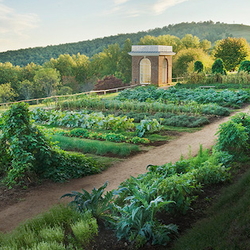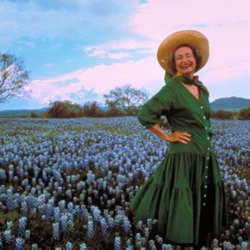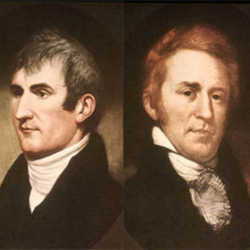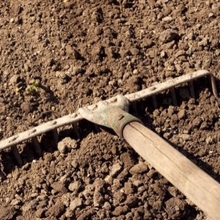(Editor's Note: This article was originally published on January 20, 2009. It is repeated today to commemorate President's Day in the U.S.)
As more Americans finally grasp the need to protect the environment and to enact self-sustainability, I am gleeful to report that we as a nation are getting back to gardening. Better still, we are now practicing healthier growing methods in record numbers by embracing organics.
But you know...what the world really needs now is a cute photo of the Obamas, happily turning compost or strolling through the White House veggie garden, harvesting fresh tomatoes and squash. Will it happen?
Maine environmentalist and garden activist Roger Doiron has launched a website called "Eat the View!" which is gathering petition signatures in an effort to encourage the Obamas to turn the White House lawn into a multi-acre sustainable garden. A similar campaign has been pitched by an organization called The WHO Farm, aka The White House Organic Farm Project.
Returning horticulture to the Oval Office makes sense. After all, the White House has a long, rich history of hosting gardeners within its walls. (And we're not talking about George W. Bush's penchant for clearing brush.)
Travelling back in time, we can find several instances where First Families of the past have proven their passion for gardening.
It was our first President, General George Washington, who launched the true American spirit of combining farming, gardening and landscaping. (Personally, I find it hard to believe that Washington ever did any such an abominable thing as chopping down a cherry tree. This story is now thought to be a legend.)
As a wealthy landowner, Washington had a lot of room to experiment. Mount Vernon in a suburb of Washington, D.C. is a true testament to plant diversity and imaginative, free-flowing design. Washington's gardening escapades were not without incident, however. In 1787 our Founding Father apparently was forced to draw up a contract with one of his gardeners, Philip Bater, to ensure that the groundsman didn't show up drunk to work.
Sadly, our first president died partially due to his devotion to farming. On December 12, 1799, Washington spent several hours inspecting his farms on horseback, enduring a combination of snow, hail and freezing rain. Upon returning, he failed to change out of his wet clothes and quickly contracted pneumonia. He passed away two days later.
John Adams developed from a farmer to a gardener with an appreciation for beauty and design thanks to both his relationship with Thomas Jefferson and his own frequent European travels. Unfortunately, the senior Adams only spent four months in the newly built Executive Mansion, but managed to have a vegetable garden constructed during that time.
 In 1801, one of America's horticultural innovators took the office of President. Upon inauguration, Thomas Jefferson immediately began making plans for renovating the gardens on the Executive Mansion grounds. Jefferson had long been a plant enthusiast and collector, and introduced true diversity to every garden he tended. It is said that during particularly difficult times during his presidency, Jefferson often retreated to garden planning as a calming distraction. He frequently traded seeds and plants with friends from Europe. After leaving office, Jefferson spent much of his time tending the gardens at Monticello, his home estate in Charlottesville, Virginia, which boasted 250 varieties of 70 species of vegetables in a 1,000-foot-long garden.
In 1801, one of America's horticultural innovators took the office of President. Upon inauguration, Thomas Jefferson immediately began making plans for renovating the gardens on the Executive Mansion grounds. Jefferson had long been a plant enthusiast and collector, and introduced true diversity to every garden he tended. It is said that during particularly difficult times during his presidency, Jefferson often retreated to garden planning as a calming distraction. He frequently traded seeds and plants with friends from Europe. After leaving office, Jefferson spent much of his time tending the gardens at Monticello, his home estate in Charlottesville, Virginia, which boasted 250 varieties of 70 species of vegetables in a 1,000-foot-long garden.
Jefferson was passionate about peas; he grew 22 varieties, and challenged his neighbors to a competition every spring to see who could get the first English pea to the table. His orchards held 170 varieties of fruit. It is stunning to think of how many plant varieties Jefferson was responsible for introducing to Americans as a result of his travels, trade and endless self-conducted plant trials. In recent years, and after experiencing some sketchy ownership, the gardens of Monticello, shown above left, have been returned to full glory and serve as, among many other things, a shining example of organic, sustainable gardening.
John Adams' son John Quincy became the 6th President of the U.S. in 1825, and inherited his father's love of plants and gardening. According to the whitehouse.gov website, Quincy was responsible for hiring John Ousley, who remained the White House gardener for the next 30 years. The younger Adams was the first President to develop the flower gardens that Jefferson had earlier laid out, and was also the first to plant ornamental trees. As an avid gardener himself, John Quincy Adams personally enjoyed planting seedlings that included fruit trees, herbs and vegetables.
During his term in the 1830s, President Andrew Jackson became a big supporter of the gardens. In 1835, he created the White House orangery (and also planted the famous Jackson magnolia on the south side of the house). The orangery was later demolished...but at least it was replaced with a greenhouse.
Around 1878, President Rutherford B. Hayes started the tradition of planting commemorative trees to represent each president. The practice continues today. Hayes was responsible for moving the location of the annual Easter Egg Roll from the Capital to the Executive Mansion lawn. He also expanded the glass conservatory which adjoined the main house at the State Room.
 Everyone remembers Eleanor Roosevelt's inspiring turn as a Victory Gardener; she grew beans and carrots on what had been the White House Lawn during the early 1940s. Spurred in part by the first lady's example, more than 20 million Americans had home gardens and grew 40% of the country's produce during World War II.
Everyone remembers Eleanor Roosevelt's inspiring turn as a Victory Gardener; she grew beans and carrots on what had been the White House Lawn during the early 1940s. Spurred in part by the first lady's example, more than 20 million Americans had home gardens and grew 40% of the country's produce during World War II.
Lady Bird Johnson, while not necessarily a vegetable gardener, still made tremendous strides in publicizing the importance of planting native species. Her Wildflower Center near Austin, TX continues to educate and inspire. The Center also currently serves as the official Seed Bank for the state of Texas.
Jimmy Carter was a Future Farmers of America member as a kid and, as everyone knows, eventually became a successful peanut farmer. When he took up residence on Pennsylvania Avenue in the mid-1970s, however, Carter displayed a particular love for the herb garden. (His brother Billy Carter apparently had more interest in barley and hops, however.)
In recent years, gardening enthusiasm among the First Family's ranks has waned somewhat. In 2000, chef and food activist Alice Waters urged President Bill Clinton to plant a vegetable garden at the White House. "Send me the seeds, Alice" was his infamous answer, but unfortunately Bill and Hill never tilled.
If you'd like to learn more or see some of the aforementioned presidential-related gardens for yourself, many have been preserved and/or refurbished, and are open for public viewing. Likewise, the White House frequently hosts seasonal tours of its gardens and grounds.
Let's all hope that in a few years, we'll be lauding our new Commander-in-Chief for making strides to return a love of healthy, sustainable gardening to the White House...or, at least, a tolerance for broccoli.
Links:
- White House Garden Tour and Gallery: http://godc.about.com/b/2008/04/11/white-house-garden-tour-2008.htm
- George Washington's Mt. Vernon Estate and Gardens http://www.mountvernon.org/
- Thomas Jefferson's Monticello http://www.monticello.org/
- Adams National Historical Park http://www.nps.gov/adam
- Lady Bird Johnson Wildflower Center http://www.wildflower.org/
- Eat the View http://www.eattheview.org
- The WHO (White House Organic) Farm Project http://www.thewhofarm.org

















